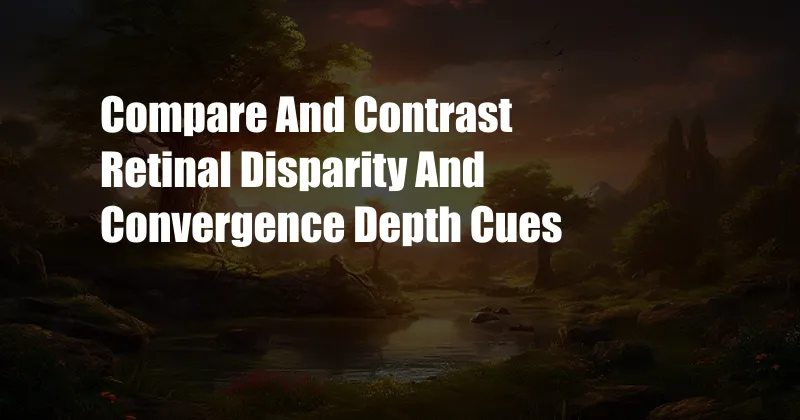
Retinal Disparity and Convergence Depth Cues: A Comprehensive Guide
Introduction: Unveiling the Secrets of Depth Perception
We humans possess an extraordinary ability to perceive the world around us in three dimensions, a feat made possible by a remarkable array of depth cues. Among these cues, retinal disparity and convergence play pivotal roles in shaping our perception of depth. In this article, we delve into the world of depth perception, exploring the fascinating mechanisms of retinal disparity and convergence, and their impact on our visual experience.
Retinal Disparity: The Magic of Binocular Vision
Retinal disparity refers to the subtle difference in the images formed on the retinas of our two eyes. When we fixate on an object, the object’s image falls on corresponding points on both retinas. However, as the object’s distance changes, the disparity between the images increases or decreases. Specialized neurons in the brain process this disparity, allowing us to subconsciously determine the relative distances of objects in our field of view.
Convergence: When Our Eyes Work Together
Convergence is another depth cue that works in concert with retinal disparity. When we look at an object, our eyes converge, or turn inward, to focus on that object. The extent of convergence provides additional information about an object’s distance. Nearer objects require greater convergence, while farther objects require less. The combination of retinal disparity and convergence helps us to accurately judge both the absolute and relative distances of objects around us.
Delving Deeper: The Brain’s Role in Depth Perception
The information gathered from retinal disparity and convergence is processed by complex neural circuits in the brain. These circuits integrate multiple cues to create a unified representation of depth. The brain also uses other cues, such as object motion, shading, and perspective, to further refine its depth perception.
Recent Advances in Depth Perception Research
In recent years, there have been significant advances in the field of depth perception research. Virtual reality and augmented reality technologies have emerged as powerful tools for studying depth perception in realistic environments. Additionally, researchers are exploring artificial intelligence algorithms that can mimic the brain’s depth processing capabilities, paving the way for potential applications in computer vision and robotics.
Tips and Expert Advice for Enhanced Depth Perception
If you are interested in improving your depth perception, here are a few tips:
- Practice Stereo Vision Exercises: Engaging in activities that require binocular vision, such as playing video games or using stereoscopes, can help to strengthen your stereo vision abilities.
- Engage in Depth Cue Training: There are specific training programs available that can help you to improve your depth perception skills through exercises and drills.
- Consult an Eye Doctor: If you have any concerns about your depth perception, it’s essential to consult an eye doctor. They can assess your vision and determine if any underlying issues need to be addressed.
FAQs on Retinal Disparity and Convergence
Q: What is the relationship between retinal disparity and convergence?
A: Retinal disparity and convergence are complementary depth cues that work together to provide accurate depth perception.
Q: How does the brain combine the information from retinal disparity and convergence?
A: The brain processes the information from retinal disparity and convergence to create a three-dimensional representation of the world.
Q: Are there any conditions that can affect retinal disparity and convergence?
A: Conditions such as strabismus (crossed eyes), amblyopia (lazy eye), and other eye muscle imbalances can affect the accuracy of retinal disparity and convergence, potentially leading to depth perception issues.
Conclusion: Unveiling the Secrets of Depth Perception
Retinal disparity and convergence are fundamental depth cues that enable us to navigate the world in three dimensions. By understanding these mechanisms, we gain a deeper appreciation for the complexity of our visual system and the amazing capabilities of the human brain. By embracing these depth cues and exploring the latest advancements in the field, we can enhance our understanding of depth perception and its applications in various domains.